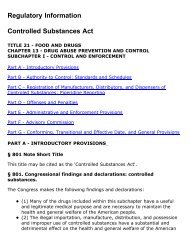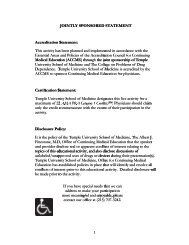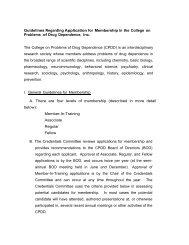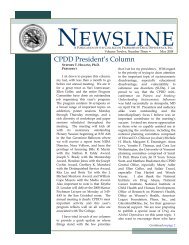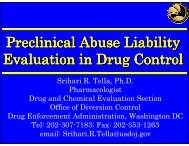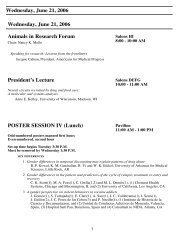CPDD 72nd Annual Meeting • Scottsdale, Arizona - The College on ...
CPDD 72nd Annual Meeting • Scottsdale, Arizona - The College on ...
CPDD 72nd Annual Meeting • Scottsdale, Arizona - The College on ...
Create successful ePaper yourself
Turn your PDF publications into a flip-book with our unique Google optimized e-Paper software.
181<br />
BRIEF INTERVENTION TO REDUCE CAFFEINE<br />
CONSUMPTION IN CAFFEINE-DEPENDENT TREATMENT<br />
SEEKERS.<br />
Daniel P Evatt 1 , L M Juliano 2 , J Cohen 1 , R R Griffiths 1 ; 1 Psychiatry and<br />
Behavioral Sciences, Johns Hopkins University School of Medicine, Baltimore,<br />
MD, 2 Psychology, American University, Washingt<strong>on</strong>, DC<br />
Aims: Physicians frequently advise caffeine reducti<strong>on</strong> or cessati<strong>on</strong> in individuals<br />
who have certain medical c<strong>on</strong>diti<strong>on</strong>s. Some daily users are unable to reduce or<br />
quit caffeine use, despite a desire to do so. <str<strong>on</strong>g>The</str<strong>on</strong>g> purpose of this study was to develop<br />
a brief manualized treatment to reduce caffeine c<strong>on</strong>sumpti<strong>on</strong> in caffeinedependent<br />
users.<br />
Methods: Participants were 106 daily caffeine users who were interested in cutting<br />
back or quitting their caffeine c<strong>on</strong>sumpti<strong>on</strong>. Fifty-four participants, who<br />
used 200mg or more of caffeine per day and fulfilled DSM-IV criteria for substance<br />
dependence applied to caffeine, returned for the treatment sessi<strong>on</strong>.<br />
Participants were randomized to receive a <strong>on</strong>e-hour treatment after an<br />
Immediate (return in 1-2 weeks) or Delay (return in 5-6 weeks) c<strong>on</strong>diti<strong>on</strong>. Daily<br />
caffeine diaries were kept from 1 week before treatment to 5 weeks post-treatment.<br />
Timeline follow-back assessments were taken at 6, 12, and 26 weeks.<br />
Results: Mean age was 41.4 years. <str<strong>on</strong>g>The</str<strong>on</strong>g> majority of the sample was Caucasian<br />
(80%) and female (59%). Forty-four percent were married and 72% employed.<br />
A repeated measures ANOVA was c<strong>on</strong>ducted with Time (Screening, Treatment)<br />
and Delay (Delay, Immediate) entered as factors. A separate analysis was c<strong>on</strong>ducted<br />
with Time (Treatment, Week1, Week2, Week3, Week4, Week5) and<br />
Delay (Delay, Immediate) entered as factors. No significant effect of Delay was<br />
observed in either analysis. Findings revealed a significant reducti<strong>on</strong> in caffeine<br />
c<strong>on</strong>sumpti<strong>on</strong> across the first 5 weeks of treatment, F(2.18, 67.52) = 36.98, p <<br />
.001, ηp2 = .54. Mean reducti<strong>on</strong>s in caffeine from Treatment (468.9mg) to<br />
Week5 (159.1) were 66%. Reducti<strong>on</strong>s were maintained at 6, (159.7mg), 12<br />
(136.2mg), and 26 weeks (133.6mg).<br />
C<strong>on</strong>clusi<strong>on</strong>s: <str<strong>on</strong>g>The</str<strong>on</strong>g> study dem<strong>on</strong>strates that a brief behavioral treatment is efficacious<br />
for reducing caffeine intake in caffeine dependent users.<br />
Financial Support: Supported by NIDA R01 DA03890<br />
183<br />
COMPARING HEROIN USERS AND PRESCRIPTION<br />
OPIOID USERS SEEKING SUBOXONE® TREATMENT FOR<br />
OPIOID DEPENDENCE.<br />
Jacqueline Fahey, M Hillhouse, J Jenkins, R Raws<strong>on</strong>, W Ling; Integrated<br />
Substance Abuse Programs, University of California, Los Angeles, Los Angeles, CA<br />
Aims: <str<strong>on</strong>g>The</str<strong>on</strong>g> number of Americans receiving treatment for abuse of pain medicati<strong>on</strong>s<br />
increased 167% from 360,000 to 601,000 pers<strong>on</strong>s between 2002 and 2008<br />
(SAMHSA, 2009), and treatment providers are likely treating a growing percentage<br />
of prescripti<strong>on</strong> opioid (PO) users. Research has compared heroin and<br />
PO users in both opioid treatment program (OTP) and office-based settings<br />
(Banta-Green et al., 2009; Torringt<strong>on</strong> et al., 2007), and the current study<br />
expands study findings to include opioid-dependent participants receiving<br />
Subox<strong>on</strong>e® in a research clinic setting.<br />
Methods: In an <strong>on</strong>going NIDA-funded trial comparing the effectiveness of combined<br />
pharmacotherapy and behavioral therapy for opioid dependence, the first<br />
177 treatment-seeking participants self-reported being primarily heroin users (n<br />
= 113) or PO users (n = 64).<br />
Results: Baseline analyses show that the heroin and PO groups did not vary by<br />
gender, educati<strong>on</strong> level, age at first opioid use, or recent poly-substance use.<br />
Preliminary analyses indicate differences between the two groups, including<br />
mean number of lifetime drug treatment episodes [heroin = 6.13(8.49); PO =<br />
2.12(2.38)], and pain as the main reas<strong>on</strong> for seeking treatment (5.3% of heroin<br />
users compared to 16.9% of PO users). Interestingly, a greater percentage of the<br />
heroin group reported using other opioids (96.4%), whereas less than half of the<br />
PO group (49.2%) reported past heroin use. Also presented are findings <strong>on</strong><br />
group differences in HIV risk behavior, medical and psychiatric problems, and<br />
treatment retenti<strong>on</strong>.<br />
C<strong>on</strong>clusi<strong>on</strong>s: Findings from this study have important implicati<strong>on</strong>s for treatment<br />
providers, who may use the informati<strong>on</strong> to adapt treatment plans for either<br />
heroin- or PO-dependent patients presenting for treatment with Subox<strong>on</strong>e®.<br />
Financial Support: NIDA Grant DA020210<br />
<str<strong>on</strong>g>CPDD</str<strong>on</strong>g> <str<strong>on</strong>g>72nd</str<strong>on</strong>g> <str<strong>on</strong>g>Annual</str<strong>on</strong>g> <str<strong>on</strong>g>Meeting</str<strong>on</strong>g> <str<strong>on</strong>g>•</str<strong>on</strong>g> <str<strong>on</strong>g>Scottsdale</str<strong>on</strong>g>, <str<strong>on</strong>g>Ariz<strong>on</strong>a</str<strong>on</strong>g><br />
46<br />
182<br />
THE INFLUENCE OF NEURO-COGNITIVE IMPAIRMENT<br />
ON INTERVENTION OUTCOMES AMONG INJECTION<br />
DRUG USERS LIVING WITH HIV/AIDS.<br />
I Ezeabogu, Michael Copenhaver, J Potrepka, A Meier; University of<br />
C<strong>on</strong>necticut, Storrs, CT<br />
Aims: Drug- and sex-related HIV risk behaviors and sub-optimal adherence to<br />
HIV medicati<strong>on</strong> regimens can jeopardize the health of HIV–infected injecti<strong>on</strong><br />
drug users (IDUs) and threaten community health. Findings to date indicate that<br />
it is feasible to deliver a brief behavioral risk reducti<strong>on</strong>/medicati<strong>on</strong> adherence<br />
group interventi<strong>on</strong> to HIV-infected IDUs in a community-based setting. Being<br />
adherent to HAART or being able to successfully participate in behavioral interventi<strong>on</strong>s<br />
targeting adherence and harm reducti<strong>on</strong> often requires a relatively high<br />
level of cognitive abilities. HIV infecti<strong>on</strong> and substance abuse are known to independently<br />
affect the central nervous system and this can result in neuro-cognitive<br />
impairment. In combinati<strong>on</strong>, their effects can be even more profound and<br />
this is directly relevant to interventi<strong>on</strong> development because a significant number<br />
of people living with HIV/AIDS have a positive history of substance abuse.<br />
We aimed to examine the impact of cognitive impairment <strong>on</strong> outcomes am<strong>on</strong>g<br />
HIV-infected IDUs participating in our CHRP+ interventi<strong>on</strong>.<br />
C<strong>on</strong>clusi<strong>on</strong>s: We evaluated the extent to which changes in Informati<strong>on</strong>,<br />
Motivati<strong>on</strong>, and Behavioral skills (IMB) with respect to medicati<strong>on</strong> adherence<br />
and sex- and drug-risk behavior outcomes are predicted by cognitive impairment<br />
following the brief 4-sessi<strong>on</strong> Community-Friendly Health Recovery Program for<br />
HIV-infected Drug Users (CHRP+). Findings suggest that it may be helpful to<br />
specifically tailor such behavioral interventi<strong>on</strong>s to accommodate cognitive<br />
impairment. Implicati<strong>on</strong>s for the design of future interventi<strong>on</strong>s are discussed.<br />
Financial Support: Funding provided by NIH/NIDA K23 DA17015<br />
(Copenhaver PI), Optimizing HIV preventi<strong>on</strong> for HIV-positive Injecti<strong>on</strong><br />
Drug Users.<br />
184<br />
ESTIMATED CANNABIS-ASSOCIATED RISK OF<br />
DEVELOPING A NEWLY INCIDENT DEPRESSION SPELL:<br />
FOCUS ON EARLY-ONSET CANNABIS USE.<br />
Brian Fairman, J C Anth<strong>on</strong>y; Epidemiology, Michigan State University, East<br />
Lansing, MI<br />
Aims: In recent studies, there has been focus <strong>on</strong> suspected mood disturbances<br />
due to early-<strong>on</strong>set cannabis use (EOCU with <strong>on</strong>set < 18 years). We seek to estimate<br />
suspected EOCU-associated excess risk of experiencing a depressi<strong>on</strong> spell<br />
in adulthood.<br />
Methods: Data are from the 2005-2007 United States Nati<strong>on</strong>al Surveys <strong>on</strong> Drug<br />
Use and Health for n<strong>on</strong>-instituti<strong>on</strong>alized community-dwelling residents aged 12<br />
or older (n=103,432 after exclusi<strong>on</strong> of 54,719 pers<strong>on</strong>s 12-17 years old at survey,<br />
8,169 with pre-adult depressi<strong>on</strong> spell, and 299 missing <strong>on</strong> crucial data). Logistic<br />
regressi<strong>on</strong> was used to estimate relative risk (RR) while taking into account sampling<br />
weights and the complex sample structure.<br />
Results: An estimated 31% of adult <strong>on</strong>set depressi<strong>on</strong> spell cases had used<br />
cannabis before 18 compared to 22% of n<strong>on</strong>-cases (unadjusted RR = 1.7; 95%<br />
C<strong>on</strong>fidence Interval, CI = 1.6, 1.8; p



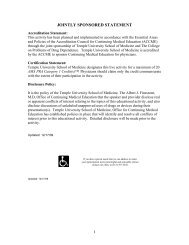
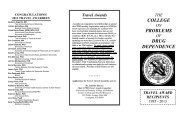
![2013SYMP AND WORKSHOP LIST[web]](https://img.yumpu.com/35325424/1/190x245/2013symp-and-workshop-listweb.jpg?quality=85)
